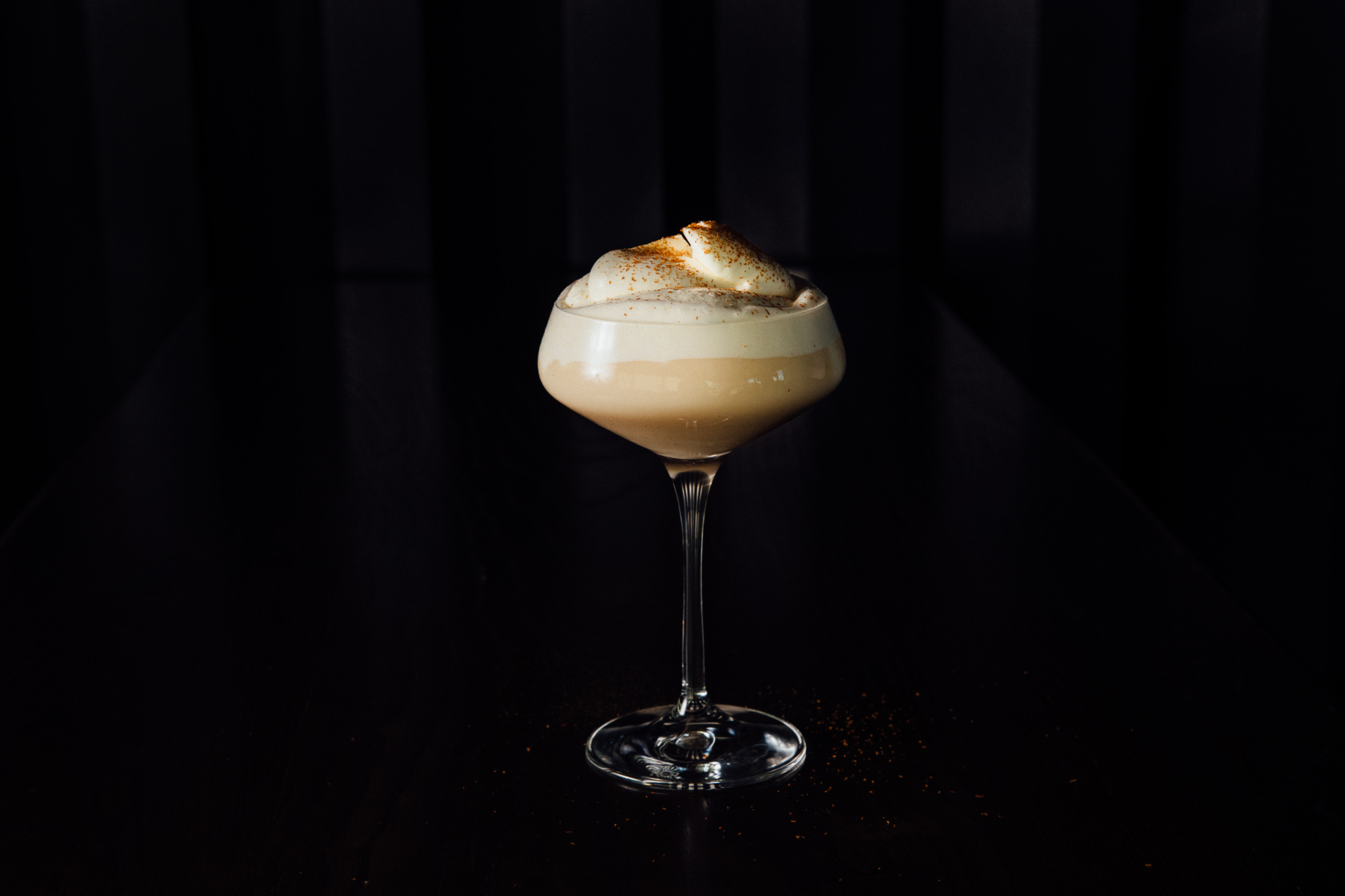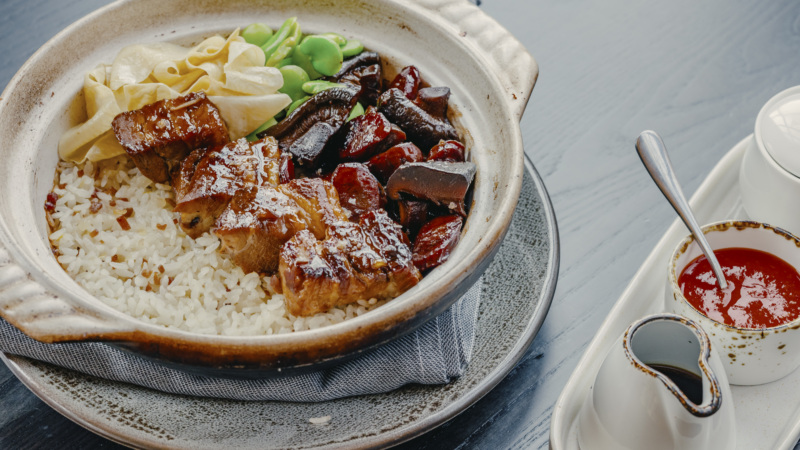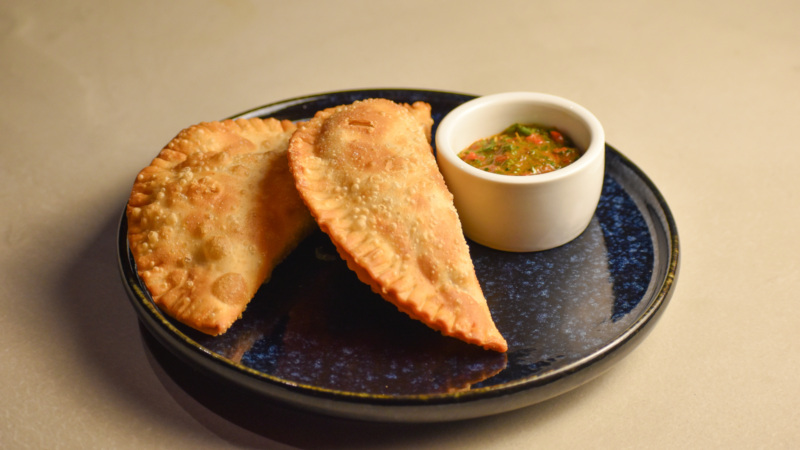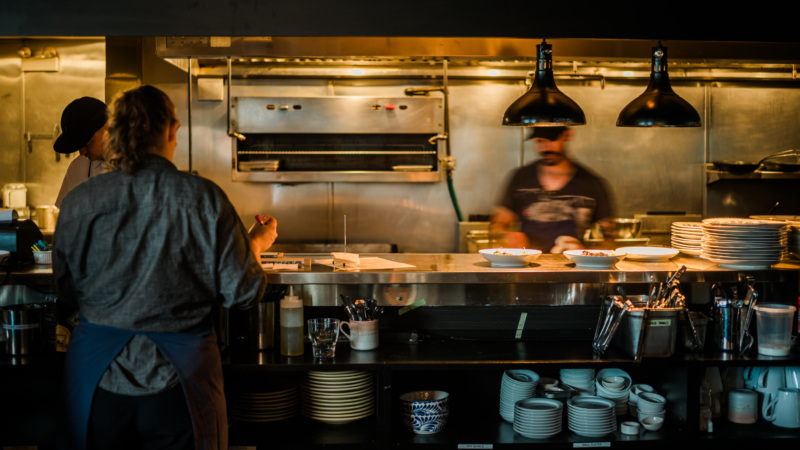
What to Eat and Drink at Wicker Park’s New Mexican-Japanese Cocktail Bar
Meet Valedor, a dramatic new Mexican-Japanese cocktail bar with moody low lighting and petite tables bringing a new kind of fusion to Wicker Park in the former Fairgrounds Coffee & Tea space.
Valedor (Spanish for “brave”) is inspired by the influx of Japanese immigrants to Mexico City after World War II and the Little Tokyo community they built there. Inside, time stops: windows are blacked out, and a cozy partially enclosed nook to the side of the bar is the most romantic seat in the house. Start with a hot sake to warm up on a frigid Chicago night, or acquire a fruity foam mustache from a colorful flight of sakeritas in passionfruit, strawberry, and cucumber flavors.
“A lot of our cocktails are not cocktails in the traditional sense,” says bartender Alex Beraza, who was previously at Pigtail by José Andrés. “They might not be shaken or stirred, but they’re made with a culinary approach. All of our cocktails have an extra element — something we’re cooking or preparing in advance.”
While cocktails are the focus, there’s also a tightly focused food menu (seven items total), emanating from the postage-stamp sized kitchen. Snacks here take the fusion concept further, including cross-cultural creations like al pastor gyoza and “birriyaki” with consommé takoyaki sauce, courtesy of Spearhead Hospitality (The Robey, Canal Street Market).
If it all sounds like a lot, don’t overthink things. “You have to submit to the moment,” Beraza says. “And you’ll be taken care of.” What else to expect? Here are five more can’t-miss cocktails and bar bites for your visit.


Horchata Two Ways
“This was a no-brainer,” Bareza says. “Before we even came up with the horchata cocktail, we knew we wanted to have horchata on our non-alcoholic menu. It’s a classic Mexican drink and we’ll always serve it. The difficulty was in trying to figure out where the Japanese element could feature into a horchata cocktail. We tried a bunch of different methods to link these two ideas, and what worked the best was adding our dry house sake — it’s very full-bodied and floral, but also tempers the sweetness of the horchata.”
The horchata is made from scratch, meaning this a prep-intensive cocktail. “Our horchata is heavy on the cinnamon, a bit sweeter, and pretty rich. We essentially built the entire cocktail in the background,” Bareza says. That same base is then mixed with heavy cream in an iSi canister to make a foam, which creates a fluffy horchata cloud on top. “Different textures are really important in the cocktail program,” Bareza says.


Beats “N” Y’gurt
“This drink is based on a beet salad,” Beraza says. “But it doesn’t taste like you think it might.” It features a rich, creamy texture (thanks to Greek yogurt); a deep magenta color; and an enticing interplay of nutty pistachio, sweet earthy beets, and tart blood orange flavors. The combination is perfectly balanced and visually quite memorable. “There are essentially two sections on our menu: our tongue in cheek take on classics, and then stranger things, where we like to think that we’re adding something fresh to cocktail culture,” Bareza says. This one falls squarely in the ‘stranger things’ camp.
“There are two types of beets in this one — golden beets to add brightness and red beets to provide a deep earthiness,” Bareza says. “We also make an orange oleo-saccharum to draw out the citrusy component and sweetness that we want. I think Greek yogurt is really underutilized as an ingredient in cocktails. I like what yogurt does to the drink — it fills your whole palate.”


Sake Gazpacho
“This is a cocktail the staff is so excited about,” Beraza says. “A lot of people assume that this is like a Bloody Mary, but it doesn’t taste anything like that. We’re making a very traditional gazpacho for a non-traditional cocktail. We batch this in advance, and it takes us two hours to make. There’s no cooking involved, per se, but everything is blended together,” he explains. (The bar makes 20-liter batches of gazpacho every two weeks.)
“We make the soup, then clarify it three times to remove all the solids. Once the viscosity is gone, you’re left with a really bright, vegetable cordial. Right before serving, we let it infuse for about 10 more minutes in the porthole [pictured]. The visual element shows off all of the ingredients in the gazpacho tableside, so guests can see the two types of tomato, cucumber, celery, rosemary, and lime.”


NY Strip Katsu Sando
“We wanted to make this somewhat higher-end, so we used grass-fed New York strip rather than pork or chicken,” says Spearhead Hospitality executive chef Michael Elliott. “We do a really intricate cleaning process to make sure it’s a clean bite with no sinew. We bread it and fry it, then serve it with a pretty traditional BBQ-like black garlic katsu sauce. We wanted some texture, so I added a chile crunch slaw — we make our own chile crisp in house and mix that with cabbage and Kewpie mayo,” he says.
Due to space constraints, the team nearly decided not to build a kitchen. But even with limited square footage, Elliott and his team are stretching the limits of what the small kitchen can accommodate. “We even make our own milk bread in house specifically for this sandwich. We tried three different recipes and eventually what we came up with is really solid — it’s light, but not too aerated, so it holds up to the sandwich. We bake 10 loaves a week and go through about two loaves a night,” he says.


Al Pastor Gyoza with Grilled Pineapple Ponzu
“This was one of the first items that came to my mind when I was developing the menu,” Elliott says, and it’s currently their best seller. The question was, how to translate the iconic taco to dumpling form? Elliott zeroed in on the dipping sauce to bridge both cultures, and spent hours looking at different ponzu recipes before coming up with a pineapple-enhanced version of his own. “Instead of putting the pineapple inside of the dumpling, we hard-roast it on the flattop to give it a lot of char, then we juice it and season it with smoked shoyu, regular shoyu, lime juice, and a little sugar. There’s [traditional taco accompaniments] diced onion and cilantro in the ponzu bowl, too. Eaten all together, it tastes like a taco.”
Amber Gibson is a Chicago-based journalist specializing in travel, food, and wine. Her work has appeared in Departures, Food & Wine, Saveur, Bon Appétit, and Travel + Leisure. Follow her here; follow Resy too.




















